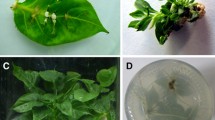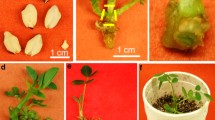Abstract
De-embryonated cotyledon explants of peanut were co-cultivated under different conditions with Agrobacterium tumefaciens harbouring pIG121hm plasmid carrying intron-containing β-glucuronidase as a reporter while hygromycin phosphotransferase and neomycin phosphotransferase as selectable marker genes. Co-cultivation duration and temperature, various antioxidants and their concentrations, bacterial strains and explant characteristics (incised and non-incised) were examined either alone or in combinations for optimization of transient expression of the reporter gene. Up to 81% transformation was recorded when non-incised explants were co-cultivated with strain EHA101 for 5 days at 21°C on shoot induction medium containing 100 mg/L l-cysteine. Addition of the optimized concentration of augmentin (200 mg/L) along with cefotaxime (200 mg/L) to the shoot induction medium not only effectively eliminated bacterial growth, but also facilitated high frequency of shoot induction. The 40 mg/L hygromycin concentration prevented complete shoot regeneration of non-transgenic explants thus considered for the regeneration of transgenics. Resistant shoots were successfully transferred to soil either by grafting or in vitro rooting. Survival rate of the grafted shoots was nearly 100% in glass-house conditions. The optimized protocol took around 3 months to generate healthy plants. Polymerase chain reaction, Southern blot hybridization, histochemical tests, segregation and hygromycin-leaf assays of selected transgenic plants showed integration of the transgene into peanut genome. No chimeras were noticed during the study.








Similar content being viewed by others
Abbreviations
- AS:
-
Acetosyringone
- BAP:
-
6-Benzylaminopurine
- DEC:
-
De-embryonated cotyledon
- GUS:
-
β-Glucuronidase enzyme
- hpt :
-
Hygromycin phosphotransferase gene
- nptII :
-
Neomycin phosphotransferase gene
- PCR:
-
Polymerase chain reaction
- SIM:
-
Shoot induction medium
- uidA :
-
β-glucuronidase gene
References
Antunez de Mayolo G, Maximova SN, Pishak S, Guiltinan MJ (2003) Moxalactam as a counter-selection antibiotic for Agrobacterium-mediated transformation and its positive effects on Theobroma cocao somatic embryogenesis. Plant Sci 164:607–615
Anuradha TS, Jami SK, Datla RS, Kirti PB (2006) Genetic transformation of peanut (Arachis hypogaea L.) using cotyledonary node as explant and a promoterless gus:nptII fusion gene based vector. J Biosci 31:235–246
Athmaram TN, Bali G, Devaiah KM (2006) Integration and expression of bluetongue VP2 gene in somatic embryos of peanut through particle bombardment method. Vaccine 24:2994–3000
Ballester A, Cervera M, Peńa L (2008) Evaluation of selection strategies alternative to nptII in genetic transformation of citrus. Plant Cell Rep 27:1005–1015
Belide S, Hac L, Singh SP, Green AG, Wood CC (2011) Agrobacterium-mediated transformation of safflower and the efficient recovery of transgenic plants via grafting. Plant Methods 7:12
Chakraborti D, Sarkar A, Das S (2006) Efficient and rapid in vitro plant regeneration system for Indian cultivars of chickpea (Cicer arietinum L.). Plant Cell Tissue Organ Cult 86:117–123
Cheng M, Jarret RL, Li Z, **ng A, Demski JW (1996) Production of fertile transgenic peanut (Arachis hypogaea L.) plants using Agrobacterium tumefaciens. Plant Cell Rep 15:653–657
da Silva Mendes AF, Cidade LC, de Oliveira MLP, Otoni WC, Soares-Filho WDS, Costa MGC (2009) Evaluation of novel beta-lactam antibiotics in comparison to cefotaxime on plant regeneration of Citrus sinensis L. Osb. Plant Cell Tissue Organ Cult 97:331–336
Dodo HW, Konan KN, Chen FC, Egnin M, Viquez OM (2008) Alleviating peanut allergy using genetic engineering: the silencing of the immunodominant allergen Ara h 2 leads to its significant reduction and a decrease in peanut allergenicity. Plant Biotechnol J 6:135–145
Dutt M, Vasconcellos M, Grosser JW (2011) Effects of antioxidants on Agrobacterium-mediated transformation and accelerated production of transgenic plants of Mexican lime (Citrus aurantifolia Swingle). Plant Cell Tissue Organ Cult 107:79–89
Egnin M, Mora A, Prakash CS (1998) Factors enhancing Agrobacterium tumefaciens-mediated gene transfer in peanut (Arachis hypogaea L.). In Vitro Cell Dev Biol Plant 34:310–318
Frame BR, Shou H, Chikwamba RK, Zhang Z, **ang C, Fonger TM, Pegg SEK, Li B, Nettleton DS, Pei ND, Wang K (2002) Agrobacterium tumefaciens-mediated transformation of maize embryo using a standard binary vector system. Physiol Plant 129:13–22
Gamborg OL, Miller RA, Ojima K (1968) Nutrient requirements of suspension cultures of soybean root cells. Exp Cell Res 50:151–158
Hoekema A, Hirsch PR, Hooykaas PJJ, Schilperoort RA (1983) A binary plant vector strategy based on separation of vir- and T-region of the Agrobacterium tumefaciens Ti-plasmid. Nature 303:179–180
Hood EE, Helmer GL, Fraley RT, Chilton MD (1986) The hypervirulence of Agrobacterium tumefaciens A281 is encoded in a region of pTiBo542 outside of T-DNA. J Bacteriol 168:1291–1301
Ieamkhang S, Chatchawankanphanich O (2005) Augmentin as an alternative antibiotic for growth suppression of Agrobacterium for tomato (Lycopersicon esculentum) transformation. Plant Cell Tissue Organ Cult 82:213–220
Jefferson RA, Kavanagh TA, Bevan MW (1987) GUS Fusions: B-glucosidase as sensitive and versatile gene fusion marker in higher plants. EMBO J 6:3901–3907
** S, Liang S, Zhang X, Nie Y, Guo X (2006) An efficient grafting system for transgenic plant recovery in cotton (Gossypium hirsutum L.) Plant Cell Tissue Organ Cult 85:181–185
Kim JS, Lee SY, Park SU (2008) Resveratrol production in hairy root culture of peanut, Arachis hypogaea L. transformed with different Agrobacterium rhizogenes strains. Afr J Biotechnol 7:3788–3790
Krishnamurthy KV, Suhasini K, Sagare AP, Meixner M, de Kathen A, Pickardt T, Schieder O (2000) Agrobacterium mediated transformation of chickpea (Cicer arietinum L.) embryo axes. Plant Cell Rep 19:235–240
Kumar V, Campbell LM, Rathore KS (2011) Rapid recovery- and characterization of transformants following Agrobacterium-mediated T-DNA transfer to sorghum. Plant Cell Tissue Organ Cult 104:137–146
Li Z, Jarret RL, Demski JW (1997) Engineered resistance to tomato spotted wilt virus in transgenic peanut expressing the viral nucleocapsid gene. Transgenic Res 6:297–305
Livingstone DM, Hampton JL, Phipps PM, Grabau EA (2005) Enhancing resistance to sclerotinia minor in peanut by expressing a barley oxalate oxidase gene. Plant Physiol 137:1354–1362
Luo J, Gould JH (1999) In vitro shoot-tip grafting improves recovery of cotton plants from culture. Plant Cell Tissue Organ Cult 57:211–213
Magbanua ZV, Wilde HD, Roberts JK, Chowdhury K, Abad J, Moyer JW, Wetzstein HY, Parrott WA (2000) Field resistance to tomato spotted wilt virus in transgenic peanut (Arachis hypogaea L.) expressing an antisense nucleocapsid gene sequence. Mol Breed 6:227–236
McKently AH, Moore GA, Doostdar H, Niedz RP (1995) Agrobacterium-mediated transformation of peanut (Arachis hypogaea L.) embryo axes and the development of transgenic plants. Plant Cell Rep 14:699–703
Medina-Bolivar F, Condori J, Rimando AM, Hubstenberger J, Shelton K, O’Keefe SF, Bennett S, Dolan MC (2007) Production and secretion of resveratrol in hairy root cultures of peanut. Phytochemistry 68:1992–2003
Murashige T, Skoog F (1962) A revised medium for rapid growth and bioassays with tobacco tissue cultures. Physiol Plant 15:473–497
Niu C, Akasaka-Kennedy Y, Faustinelli P, Joshi M, Rajasekaran K, Yang H, Chu Y, Cary J, Ozias-Akins P (2009) Antifungal activity in transgenic peanut (Arachis hypogaea L.) conferred by a nonheme chloroperoxidase gene. Peanut Sci 36:126–132
Ohta S, Mira S, Hattori T, Nakamura K (1990) Construction and expression in tobacco of a β-glucuronidase (GUS) reporter gene containing an intron within the coding sequence. Plant Cell Physiol 31:805–813
Olhoft PM, Flagel LE, Donovan CM, Somers DA (2003) Efficient soybean transformation using hygromycin B selection in the cotyledon-node method. Planta 216:723–735
Opabode JT (2006) Agrobacterium-mediated transformation of plants: emerging factors that influence efficiency. Biotechnol Mol Biol Rev 1:12–20
Qiushen Z, Bao J, Likun L, **anhua X (2005) Effects of antioxidants on the plant regeneration and GUS expressive frequency of peanut (Arachis hypogaea) explants by Agrobacterium tumefaciens. Plant Cell Tissue Organ Cult 81:83–90
Sharma KK, Anjaiah V (2000) An efficient method for the production of transgenic plants of peanut (Arachis hypogaea L.) through Agrobacterium tumefaciens-mediated genetic transformation. Plant Sci 159:7–19
Singsit C, Adang MJ, Lynch RE, Anderson WF, Wang AM, Cardineau G, Ozias-Akins P (1997) Expression of a Bacillus thuringiensis cry1A(c) gene in transgenic peanut plants and its efficacy against lesser cornstalk borer. Transgenic Res 6:169–176
Still PE, Plata MI, Campbell RJ, Bueno LC, Chichester EA, Niblett CL (1987) Regeneration of fertile Arachis paraguariensis plants from callus and suspension cultures. Plant Cell Tissue Organ Cult 9:37–43
Tiwari S, Tuli R (2008) Factors promoting efficient in vitro regeneration from de-embryonated cotyledon explants of Arachis hypogaea L. Plant Cell Tissue Organ Cult 92:15–24
Tiwari S, Tuli R (2009) Multiple shoot regeneration in seed-derived immature leaflet explants of peanut (Arachis hypogaea L.). Sci Hortic 121:223–227
Tiwari S, Mishra DK, Singh A, Singh PK, Tuli R (2008) Expression of a synthetic cry1EC gene for resistance against Spodoptera litura in transgenic peanut (Arachis hypogaea L.). Plant Cell Rep 27:1017–1025
Tiwari S, Mishra DK, Roy S, Singh A, Singh PK, Tuli R (2009a) High level expression of a functionally active cholera toxin B: rabies glycoprotein fusion protein in tobacco seeds. Plant Cell Rep 28:1827–1836
Tiwari S, Verma PC, Singh PK, Tuli R (2009b) Plants as bioreactors for the production of vaccine antigens. Biotechnol Adv 27:449–467
Tiwari S, Mishra DK, Chandrasekhar K, Singh PK, Tuli R (2011) Expression of δ-endotoxin Cry1EC from an inducible promoter confers insect protection in peanut (Arachis hypogaea L.) plants. Pest Manag Sci 67:137–145
Uranbey S, Sevimay CS, Kaya MD, Ipek A, Sancak C, Basalma D, Er C, Özcan S (2005) Influence of different co-cultivation temperatures, periods and media on Agrobacterium tumefaciens-mediated gene transfer. Biologia Plantarum 49:53–57
Yonekura-Sakakibara K, Saito K (2006) Review: genetically modified plants for the promotion of human health. Biotechnol Lett 28:1983–1991
Acknowledgments
The authors express their gratitude to National Botanical Research Institute, Council of Scientific and Industrial Research, Lucknow, India for providing research facilities and to the Department of Science and Technology, Government of India, for a JC Bose Fellowship to Rakesh Tuli.
Author information
Authors and Affiliations
Corresponding author
Electronic supplementary material
Below is the link to the electronic supplementary material.
Rights and permissions
About this article
Cite this article
Tiwari, S., Tuli, R. Optimization of factors for efficient recovery of transgenic peanut (Arachis hypogaea L.). Plant Cell Tiss Organ Cult 109, 111–121 (2012). https://doi.org/10.1007/s11240-011-0079-4
Received:
Accepted:
Published:
Issue Date:
DOI: https://doi.org/10.1007/s11240-011-0079-4




